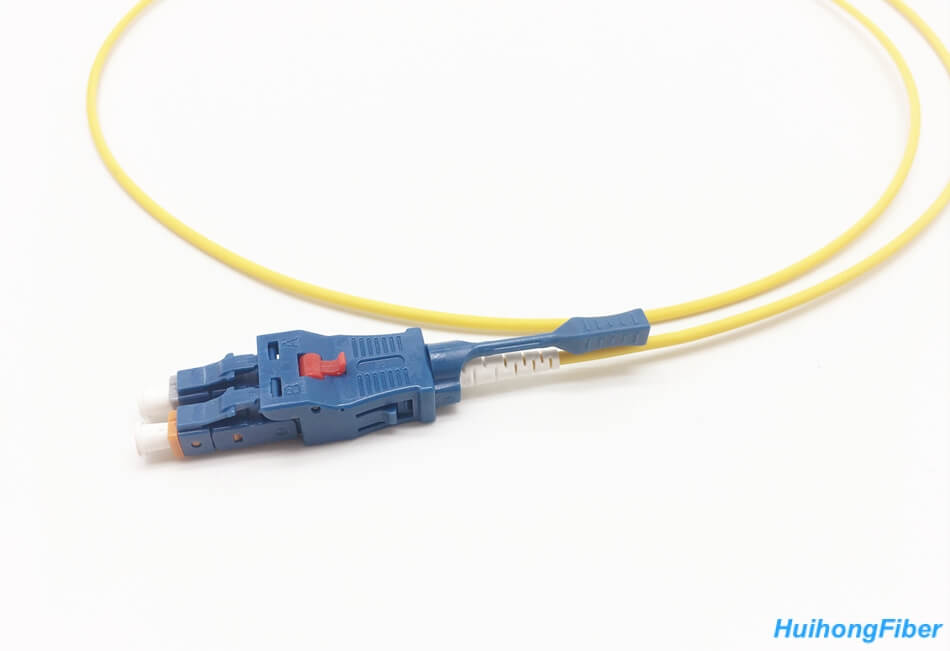The LC-LC Switchable Uniboot LC Fiber Patch Cables allows two fibers to pass through a 2.0 mm single sheath for high-density fiber wiring that requires space savings and reduced cable management issues in the data center. The LC-LC Uniboot design allows a cable to carry two fibers at the same time. The reverse polarity design allows for quick and easy polarity conversion without exposing fiber or requiring any tools.

| Connector Type | LC to LC | Polish Type | UPC to UPC |
| Fiber Mode | OS2 9/125μm | Wavelength | 1310/1550nm |
| Fiber Count | Duplex | Fiber Grade | G.657.A1(Compatible with G.652.D) |
| Insertion Loss | ≤0.2dB | Return Loss | ≥50dB |
| Attenuation at 1310 nm | 0.36 dB/km | Attenuation at 1550 nm | 0.22 dB/km |
| Minimum Bend Radius | 10mm | Cable Diameter | 2.0mm |
| Pull-out Force | 100N | Durability | 500 Cycles |
| Cable Jacket | PVC | Jacket Color | Yellow |
| Operating Temperature | -40 to 85°C | Storage Temperature | -45 to 85°C |
G.652D is the fiber-optic fiber model in fiber optic cable, representing the non-dispersion displacement single-mode fiber, is currently the most widely used single-mode fiber. Commercially launched in 1983, its scattered wavelength at 1310nm, at 1550nm at the minimum attenuation, but there is a larger positive dispersion, about 8ps (nm/km), the working wavelength can be selected 1310nm, can also choose 1550nm.
This fiber is the most widely used fiber, most of the fiber has been laid, fiber optic cable is most of this kind of fiber. In the late 1970s, attempts were made to replace light-emitting diode light sources with developed long-life semiconductor lasers to obtain longer communication distances and greater communication capacity, but pattern noise occurs when lasers are transmitted in multimode optical fibers. In order to overcome the mode noise, in 1980 successfully developed a single-mode fiber (non-dispersive displacement single-mode fiber), referred to as standard single-mode fiber, which ITU-T recommends as G.652 fiber. Because the design idea of single-mode fiber is to transmit only one mode, there is no mode noise that occurs when transmission occurs in multimode fiber. Therefore, in the mid-1980s, 140Mbit/s optical fiber communication system consisting of laser light source and standard single-mode fiber, in which the relay distance and transmission capacity far exceeded the transmission system of coaxial cable, so that the optical fiber communication system gradually replaced the copper cable communication, becoming the main communication mode adopted in the telecommunications industry.
The G.657 access network with bending attenuation insensitive single-mode fiber optic cable characteristics” is the standard that ITU-T issued in November 2006.
G.657 Fiber is the latest fiber variety developed based on G.652 fiber to achieve the goal of fiber-to-the-home. The main characteristic of this type of fiber is its excellent bending resistance, which achieves a bending radius of 1/4 to 1/2 of the conventional G.652 fiber. G.657 fiber sub-A, B two subcategories, in which G.657A fiber performance and its application environment and G.652D type fiber similar, can be in the 1260 to 1625nm wide wavelength range (i.e. O, E, S, C, L5 working bands) work The G.657B fiber mainly works at 1310nm, 1550nm and 1625nm 3 wavelength windows, which is more suitable for the transmission of FTTH information, installation in the interior or building and other narrow places.
Has the polarity changed when running a fiber jumper? How long did it take you to finish the work? Are you wrong and polarity is a complicated thing. Engineers must be very careful to ensure that the transmit signal (Tx) on one side matches the corresponding receiver (Rx) on the other side. If polarity does not match, signal transmission may be affected.
Lc switchable single-boot cable is your choice. We all know that the polarity conversion of traditional LC cables will require re-terminating the connectors. This can take a lot of time and cause errors. Also, you need special tools to complete the process. Unlike common LC jumpers, this switchable single-boot cable supports polarity switching without re-terminating the connector. You can quickly change polarity in the field without using tools to change the correct fiber mapping polarity.
The fiber will not be damaged. In addition to polarity issues, engineers may experience space and airflow constraints when building infrastructure in high-density data centers. What’s the matter? Switchable Uniboot cables are definitely a good choice. The cable is designed as a round-style 2mm jack cable, rather than a zip cord duplex cable, reducing cable size and increasing density by 60%. The switchable single-boot cable is therefore conducive to space saving and cooling.
